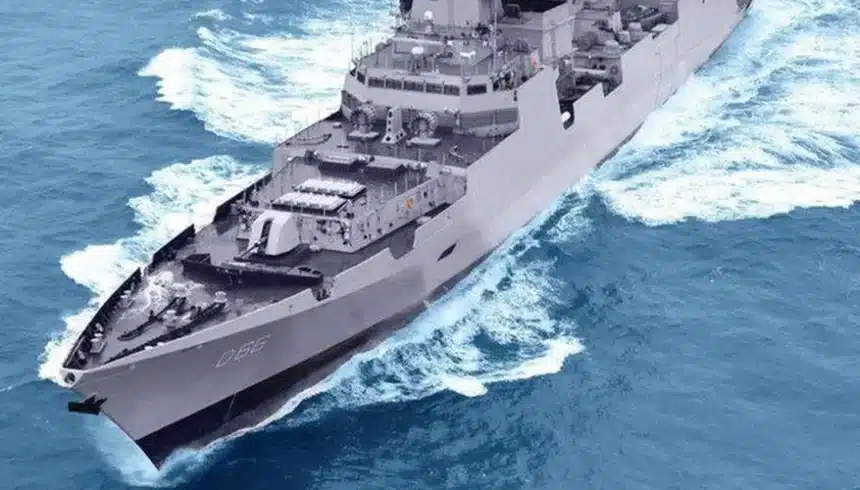Image: Twitter/@Defence_XP
INS Visakhapatnam, a P15B stealth guided missile destroyer, was commissioned into the Indian Navy in the presence of Raksha Mantri Shri Rajnath Singh at the Naval Dockyard, Mumbai on 21 November 2021. The event marks the formal induction of the first of the four ‘Visakhapatnam’ class destroyers, indigenously designed by the Indian Navy’s in-house organisation Directorate of Naval Design and constructed by Mazagon Dock Shipbuilders Limited, Mumbai. The vessel is named after the historic city of Andhra Pradesh on the east coast, Visakhapatnam, the ‘City of Destiny’,
Raksha Mantri termed INS Visakhapatnam as a symbol of the growing maritime prowess of the country and a major milestone in achieving Prime Minister Shri Narendra Modi’s vision of ‘Make in India, Make for the World’. He added that the ship is a reminder of ancient and medieval India’s maritime power, shipbuilding skills and glorious history.
Feature of INS Visakhapatnam
Each vessel will measure 163m long and 17.4m wide, with a displacement of 7,300t. The ships will be operated by a crew of 350, including 50 officers and 250 sailors. The accommodation and working areas will offer superior ergonomics and habitability. The ship is propelled by four powerful Gas Turbines, in a Combined Gas and Gas (COGAG) configuration, capable of achieving speeds more than 30 knots. The ship has enhanced stealth features resulting in a reduced Radar Cross Section (RCS) achieved through efficient shaping of hull, full beam superstructure design, plated masts, and use of radar transparent materials on exposed decks. Apart from myriad indigenous equipment in the ‘Float’ and ‘Move’ categories, the destroyer is also installed with major indigenous weapons which include: –
- Medium Range Surface-to-Air Missiles (BEL, Bangalore).
- BrahMos Surface-to-Surface Missiles (BrahMos Aerospace, New Delhi).
- Indigenous Torpedo Tube Launchers (Larsen & Toubro, Mumbai).
- Anti-Submarine Indigenous Rocket Launchers (Larsen & Toubro, Mumbai).
- 76mm Super Rapid Gun Mount (BHEL, Haridwar).
Key messages
Shri Rajnath Singh appreciated the self-reliance efforts of the Indian Navy, terming Navy’s order of 39 of the 41 ships and submarines from Indian shipyards as a testament to their commitment towards achieving ‘Aatmanirbhar Bharat’. He also coveyed that Indigenous Aircraft Carrier ‘INS Vikrant‘ as an important milestone in their path to achieve ‘Aatmanir bharta’.
He reiterated that India, as a responsible maritime stakeholder, is a supporter of consensus-based principles and a peaceful, open, rule-based and stable maritime order. “In the ‘United Nations Convention on the Law of the Sea‘ (UNCLOS) of 1982, territorial waters of nations, exclusive economic zones and the principle of ‘Good order at sea‘ have been propounded. Some irresponsible nations, for the sake of their narrow partisan interests, keep on giving new and inappropriate interpretations to these international laws from hegemonic tendencies. The arbitrary interpretations create obstacles in the path of a rule-based maritime order.

